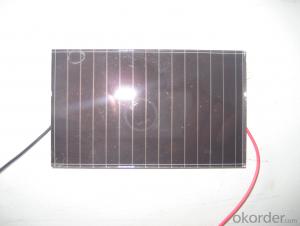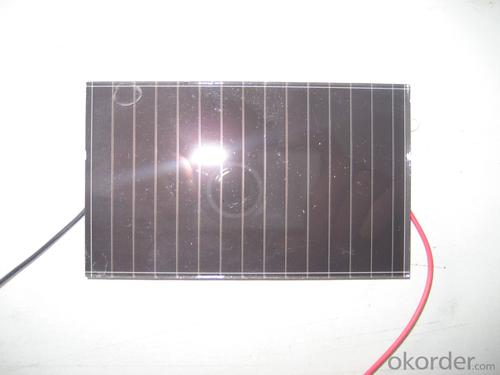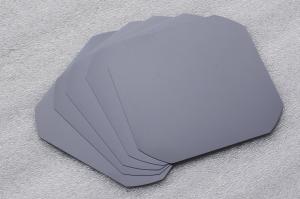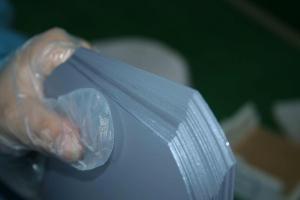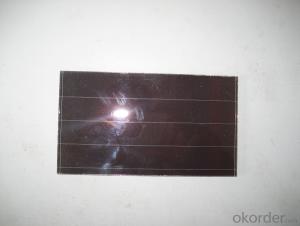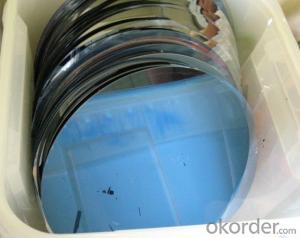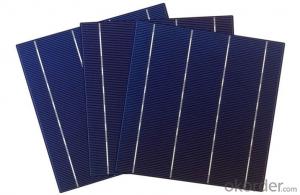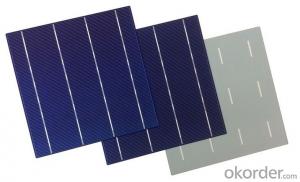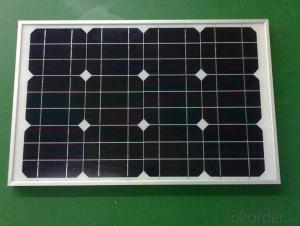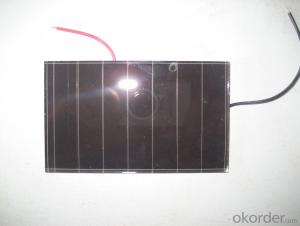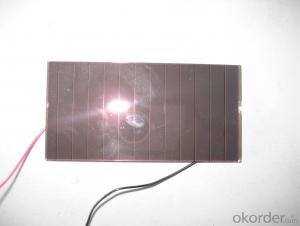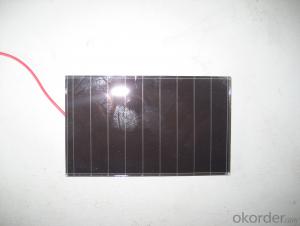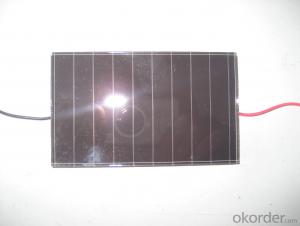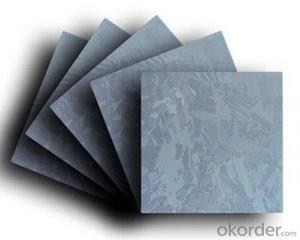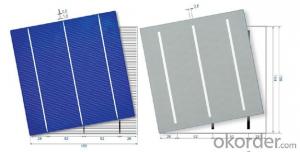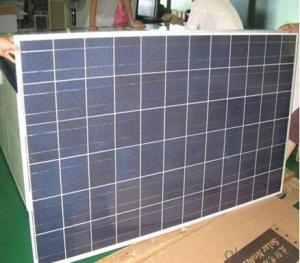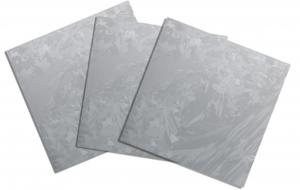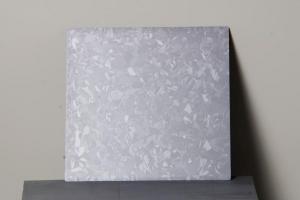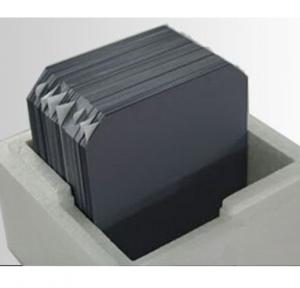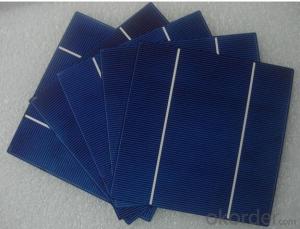Solar Grade Silicon Wafer Amorphous Silicon Dice Specification 6
- Loading Port:
- China Main Port
- Payment Terms:
- TT OR LC
- Min Order Qty:
- -
- Supply Capability:
- -
OKorder Service Pledge
OKorder Financial Service
You Might Also Like
Pv modules at present, the mainstream products are still in silicon as the main raw materials, only in terms of silicon raw material consumption, production 1 mw of crystalline silicon solar cell, need 10 to 12 tons of high purity silicon, but if use the same silicon materials used to produce thin film amorphous silicon solar cell can produce more than 200 mw.
From the perspective of energy consumption, amorphous silicon solar battery only 1-1.5 years of energy recovery period, more embodies its contribution to energy saving in the manufacturing process.
Component occupies a high proportion of costs in a photovoltaic system, the component prices directly affect the system cost, and thus affect the cost of photovoltaic power generation. Calculated at the current price of components, the same money, buy amorphous silicon products, you can get more close to 30% of the power components.
2, more power
For the same power of solar cell array, amorphous silicon solar cell is about 10% more than monocrystalline silicon, polycrystalline silicon battery power. This has been the Uni - Solar System LLC, Energy Photovoltaic Corp., Japan's Kaneka Corp., the Netherlands Energy research institute, and other organizations and experts confirmed that the Photovoltaic industry.
In sunny, that is to say, under the high temperature, amorphous silicon solar cell components can show more excellent power performance.
3, better low light response
Due to the characteristics of amorphous silicon atoms are arranged disorderly, the electron transition no longer comply with the restriction of traditional \"selection rule\", as a result, its light absorption characteristics and there are big differences monocrystalline silicon material. Amorphous silicon and monocrystalline silicon material absorption curve as shown
, amorphous silicon absorption curve has obvious three sections (A, B, C). Area A corresponding electronic transition between localized states, such as the gap state near Fermi level and to the tail state transition, the absorption coefficient is small, about 1-10 cm - 1, for this is absorbing; B area absorption coefficient with the increase of the photon energy index rose, it corresponds to the electrons from the valence band edge extension state to the conduction band localized state transition, as well as the localized electrons from the valence band tail states guide for edge extension state transition, the region's energy range is usually only about half of the electron volts, but absorption coefficient across two or three orders of magnitude, usually up to 104 cm - 1; Area C corresponds to the electrons from the valence band to the conduction band internal internal transition, the absorption coefficient is bigger, often in more than 104 cm - 1. After two absorption area is crystalline silicon eigen absorption area.
Can be seen in the figure, the intersection of two curves about 1.8 ev. It is important to note that in the visible light range (1.7 to 3.0 ev), the absorption coefficient of amorphous silicon material is almost an order of magnitude larger than the single crystal silicon. That is to say, in the morning the first part of the sun is not too strong, the second half, and it's cloudy in the afternoon under the condition of low light intensity, long wave is greater, the amorphous silicon material still has a large absorption coefficient. Again considering the amorphous silicon band gap is larger, the reverse saturation current I0 is smaller. And as mentioned the amorphous silicon battery the characteristics I - V characteristic curve of the amorphous silicon solar cell both in theory and in practical use in low light intensity has good adaptation.
• I - V characteristics of amorphous silicon cells after more than a Vm with the voltage drop slowly
In order to be convenient, we draw the I - V characteristics of two kinds of batteries on the same picture. Crystalline silicon and amorphous silicon battery I - V characteristics of general shape as shown
we see from the picture, two kinds of cells in the curve changes after exceed the maximum output power point gap is bigger. Output current of crystalline silicon cells after exceed the maximum output power point will soon fall to zero, curve steep; Rather than crystalline silicon cells output current after a long distance to fall to zero, the curve is relatively flat. Two kinds of battery Vm equivalent to about 83% of its open circuit voltage and 83% respectively.
when light intensity gradually become hour, short circuit current and open circuit voltage of solar battery will be stronger. Short circuit current decreases faster, of course, open circuit voltage decrease more slowly.
do in battery solar cell array under the condition of load, when the sun battery array of effective output voltage less than the terminal voltage of battery, battery cannot be recharged. When the light intensity gradually become hour, crystal silicon battery charging does not meet the conditions, and amorphous silicon due to the larger voltage difference, do not charge until the light is very dark, effectively increase the use of sunlight time. So, amorphous silicon cells to produce more electricity than the crystalline silicon.
4, more excellent high temperature performance
High in the outdoor environment temperature, amorphous silicon solar cell performance change, depends on the temperature, spectrum, as well as other related factors. But what is certain is: amorphous silicon than monocrystalline silicon or polycrystalline silicon are less likely to be affected by temperature.
Amorphous silicon solar cells than monocrystalline silicon, polycrystalline silicon cells have relatively small temperature coefficient of amorphous silicon solar cell output power best Pm temperature coefficient is about 0.19%, and monocrystalline silicon, polycrystalline silicon cells best output power Pm temperature coefficient is about 0.5%, when the battery work at higher temperatures, the two batteries will be a drop in the Pm, but the decline is different. They can be calculated using the following formula.
- Q: How does the quality of a solar silicon wafer affect solar cell performance?
- The quality of a solar silicon wafer greatly affects solar cell performance. A high-quality wafer ensures better efficiency, stability, and durability of the solar cell. It allows for improved absorption of sunlight, resulting in increased energy conversion and power output. On the other hand, low-quality wafers may have impurities or defects that can hinder the flow of electrons, reducing the overall performance and efficiency of the solar cell. Therefore, investing in high-quality silicon wafers is crucial for maximizing the performance and longevity of solar cells.
- Q: What is the impact of crystal orientation on solar silicon wafers?
- The crystal orientation of solar silicon wafers has a significant impact on their electrical and optical properties. The orientation determines the arrangement and alignment of atoms in the crystal lattice, which affects the efficiency and performance of solar cells. For example, monocrystalline silicon wafers with a single crystal orientation (typically <100> or <111>) have higher electron mobility and lower defect density, resulting in better conductivity and higher conversion efficiency. These wafers are more expensive to produce but offer greater energy output. Polycrystalline silicon wafers, on the other hand, consist of multiple crystal orientations and have lower electron mobility and higher defect density. They are less expensive but have lower conversion efficiency compared to monocrystalline wafers. The crystal orientation also influences the behavior of light absorption and reflection within the solar cell. The alignment of crystal planes affects the optical properties of the wafer, determining its ability to capture and convert sunlight into electricity. In summary, the crystal orientation of solar silicon wafers directly impacts their electrical conductivity, conversion efficiency, and optical properties, ultimately influencing the overall performance and cost-effectiveness of solar cells.
- Q: What is the typical efficiency degradation rate of a solar silicon wafer over time?
- The typical efficiency degradation rate of a solar silicon wafer over time is around 0.5% to 1% per year.
- Q: Can solar silicon wafers be used in recreational vehicles (RVs)?
- Yes, solar silicon wafers can be used in recreational vehicles (RVs). Solar panels made with silicon wafers are commonly used in RVs to harness solar energy and provide power for various appliances and systems while on the road or camping.
- Q: How is the wafer appearance caused? The performance of the chip half white, a class of black! Seek help!
- You should be the color difference problem is caused by the mortar temperature cutting room temperature and workshop temperature also influenced to reduce this effect only from the cleaning rod to minimize the time spent between, this is the enthusiasm of the staff problem
- Q: Can solar silicon wafers be used in solar-powered air conditioners?
- Yes, solar silicon wafers can be used in solar-powered air conditioners. These wafers are typically made from high-purity silicon and are used in solar panels to convert sunlight into electricity. In a solar-powered air conditioner, the solar panels, which contain the silicon wafers, generate electricity from the sun's energy. This electricity is then used to power the air conditioner, allowing it to operate without relying solely on the grid or traditional power sources.
- Q: What is the impact of impurities on the durability of solar silicon wafers?
- Impurities in solar silicon wafers can have a significant impact on their durability. These impurities can affect the structural integrity and electrical properties of the wafers, leading to reduced efficiency and shorter lifespan of the solar cells. Impurities like metal ions or oxygen can introduce defects in the crystal lattice, causing degradation and increased recombination of charge carriers. This can result in reduced power output and decreased overall performance of the solar panels. Therefore, minimizing impurities and ensuring high purity silicon is crucial for enhancing the durability and longevity of solar silicon wafers.
- Q: Are there any government regulations or standards for solar silicon wafers?
- Yes, there are government regulations and standards for solar silicon wafers. These regulations and standards are put in place by various governmental bodies to ensure the quality, efficiency, and safety of solar silicon wafers used in the production of solar panels. These regulations may include specifications on the purity, dimensions, chemical composition, and electrical properties of silicon wafers. Compliance with these regulations and standards is necessary for manufacturers to maintain industry standards and meet the requirements for government incentives or certifications.
- Q: What is the effect of power output on the performance of a solar silicon wafer?
- The power output of a solar silicon wafer directly impacts its performance. Higher power output indicates that the wafer can generate more electricity, leading to increased efficiency and effectiveness in converting sunlight into usable energy. A higher power output allows for greater electricity generation and better overall performance of the solar silicon wafer.
- Q: What is the role of busbars on solar silicon wafers?
- The role of busbars on solar silicon wafers is to provide a low-resistance pathway for the current generated by the photovoltaic cells. They act as conductors, connecting the individual solar cells in a series or parallel configuration, allowing for efficient flow of electricity. The busbars also help in distributing the current evenly across the surface of the solar panel, optimizing its overall performance.
Send your message to us
Solar Grade Silicon Wafer Amorphous Silicon Dice Specification 6
- Loading Port:
- China Main Port
- Payment Terms:
- TT OR LC
- Min Order Qty:
- -
- Supply Capability:
- -
OKorder Service Pledge
OKorder Financial Service
Similar products
Hot products
Hot Searches
Related keywords
